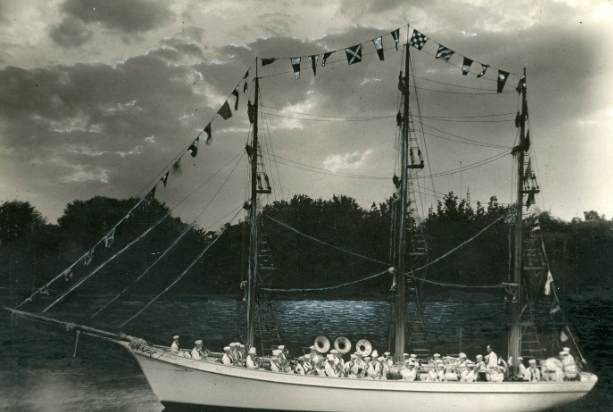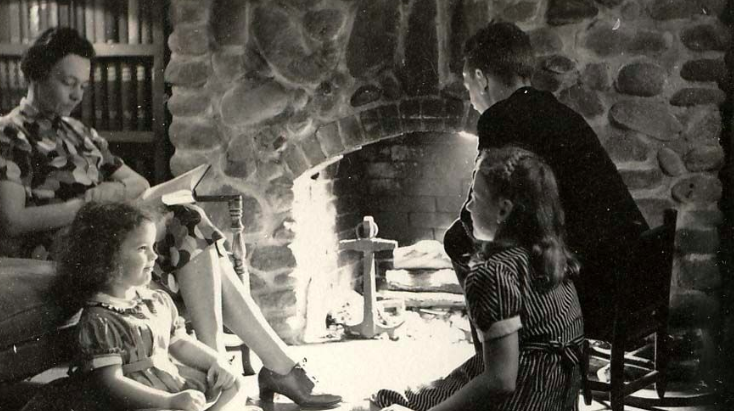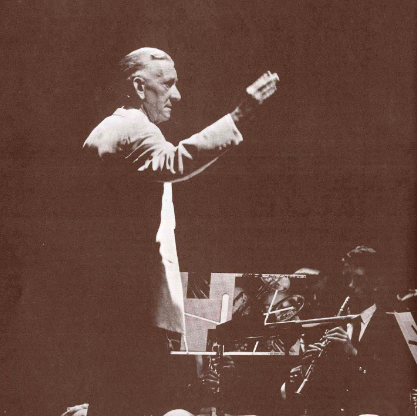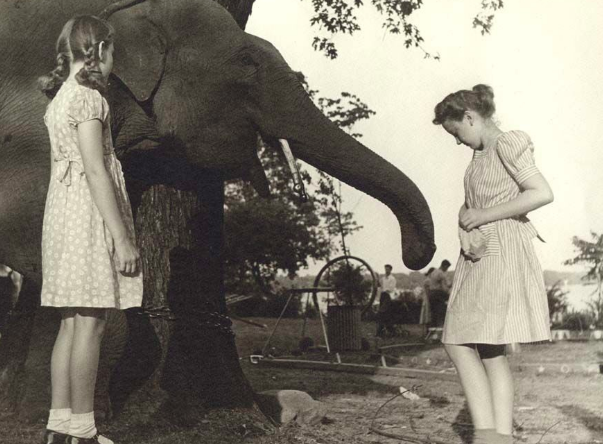A Look Back at a Unique Moment In Culver History
Photography Provided
There may have been something of a comeback for a variety of wildlife at Lake Maxinkuckee in recent years, from bald eagles to sandhill cranes, osprey to pelicans, but as far as the historical record shows, elephants have only made one appearance in the waters of the second largest natural lake in the state.
 That event dates back to the World War II years of 1942, when Col. Edward Payson, longtime Band Director at Culver Military Academy and a consummate amateur photographer, captured images of pachyderms in Culver’s town park.
That event dates back to the World War II years of 1942, when Col. Edward Payson, longtime Band Director at Culver Military Academy and a consummate amateur photographer, captured images of pachyderms in Culver’s town park.
Payson’s daughter, Martha (later Martha Ryman), can be seen feeding one of the elephants.
Martha, who died earlier this year, recalled to friends and family the story of the elephants’ presence in the park, explaining that a traveling circus sought rest, shade and water in Culver and put on a free, impromptu show in the town park as part of the stop, which also included a dip in the waters of the lake at the town beach for the grateful elephants.
Shooting photos of the event was far from Col. Payson’s first foray into photography.
A 1922 graduate of Culver Military Academy who also attended Harvard, Payson would marry the daughter of the school’s first Science Department chair, George Eisenhard, who pioneered radio communications at the Academy, launching its far-reaching radio station, WCMA, in the 1920s. Martha recalled that her grandparents owned the very first radio in the town of Culver as well and opened a window in their home so eager crowds of local listeners could gather outside and listen to broadcasts from multiple states away.
Ed Payson joined the staff of CMA in 1926 and would not only direct the band there but composed and rearranged several signature musical pieces still in use as part of its repertoire.
Perhaps most famously, he created a cherished annual tradition when, in 1942, he conceived of the first Moonlight Serenade, during which he added a unique flair to a planned concert in the Culver town park by the Midshipmen of the Culver Naval School Band.
 Payson, reticent to march the Naval School “Middies” in their white duck sailor pants through the dust on their way to the community concert, hit upon the idea of instead sailing the Naval Band to its destination by boat in a handful of the school’s naval cutters. A crowd of hundreds gathered in the park to hear the joint Academy-town band concert, heard the first strains of music across the waters of the lake as the appeared around the bend of the “Indian Trails” between Academy and town, towards the same beach where elephants swam just one summer earlier.
Payson, reticent to march the Naval School “Middies” in their white duck sailor pants through the dust on their way to the community concert, hit upon the idea of instead sailing the Naval Band to its destination by boat in a handful of the school’s naval cutters. A crowd of hundreds gathered in the park to hear the joint Academy-town band concert, heard the first strains of music across the waters of the lake as the appeared around the bend of the “Indian Trails” between Academy and town, towards the same beach where elephants swam just one summer earlier.
The three-masted O.W. Fowler sailing ship (named for former Culver Summer Schools director Commander Orie Fowler), the crown jewel of the Academy’s naval fleet, had first tasted Maxinkuckee mist in 1941 when Academy boat builder Bud Craft — who designed and constructed it on campus — declared it seaworthy and the arresting sight of its size and beauty at sail, recalling the great warships of yore, became the talk of the area.
So the summer following the “impromptu” Moonlight Serenade, 1943, the Fowler seemed the most fitting host for Naval Band as the ship made the circuit of the lake, the maiden voyage of the first “official” Moonlight Serenade, which once graced Indiana tourism maps as a “go-to” event of statewide stature. That event continues, each full moon in July, and cottagers continue to greet the ship with lights on their piers or follow it around as the band plays, while crowds continue to gather along the shore to hear the music in the summer night.
The O.W. Fowler was rebuilt in 1984 as the R.H. Ledbetter, and remains not only the largest ship on Maxinkuckee waters, but the largest three-masted ship on inland waters in the US.
 For his part, Col. Payson, something of a Renaissance man, was also a multi-instrumentalist with the South Bend Symphony. He will also long be remembered as the meticulous overseer of the largest student-run model railroad in the world (located in the lower level of the Academy’s dining hall into the mid-1980s), written up in Model Railroader Magazine in 1971.
For his part, Col. Payson, something of a Renaissance man, was also a multi-instrumentalist with the South Bend Symphony. He will also long be remembered as the meticulous overseer of the largest student-run model railroad in the world (located in the lower level of the Academy’s dining hall into the mid-1980s), written up in Model Railroader Magazine in 1971.
Payson even gained lasting regards for his artwork by way of a humorous, hand-drawn map of Culver Military Academy and the north shore of Lake Maxinkuckee, which was published in the 1930s and has often been reproduced since.
Col. Edward Payson retired from Culver Military Academy in June of 1968 as Master Instructor and Chairman of the Music and Art Department and died in 1977. Martha and Don Ryman had three daughters: Emily Payson Ryman, Ann Elizabeth Ryman Maurer and Mary Martha Ryman Lysy. Emily and Ann work today at Culver Academies.
During his lifetime, Payson had dozens of photographs printed in publications around the state and U.S. or exhibited in shows around Indiana (a number of these, provided by Martha Ryman, can be seen on the historical website of the Culver Public Library at culver.lib.in.us.
Martha Ryman, the only child of Edward and his wife Dorothy Payson, recalled fondly her role as subject for many of the hundreds of photos he staged and shot, intending to capture the unique beauty of Lake Maxinkuckee and Culver Academy, and rhythm and joy of a childhood well-lived in a small Indiana town.
A few of the most striking of these photos, of course, capture the time the elephants played in the waters of Maxinkuckee, and just about everyone – during an already war-weary summer – got to be a kid, at least for a little while.






